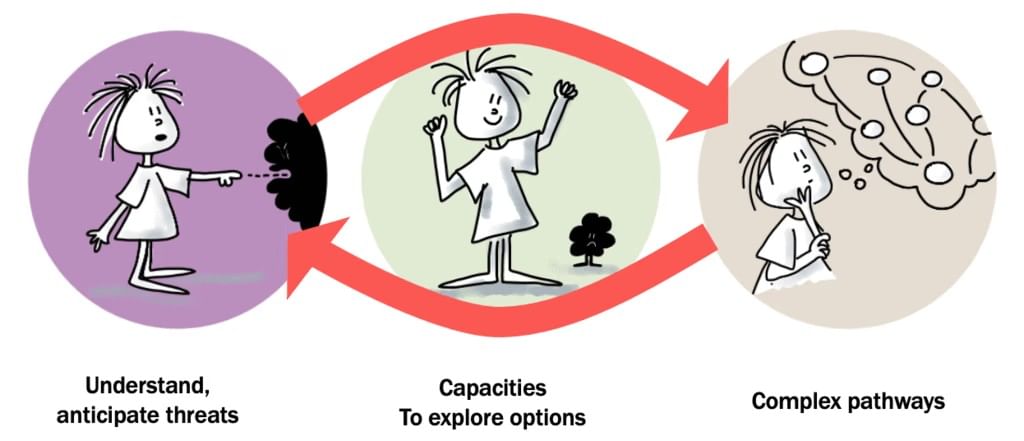Raising Resilient Kids: Building Strength for Life’s Challenges | Guide for Mindful Parenting in 2025 - LKG PDF Download
| Table of contents |

|
| Introduction |

|
| Why Resilience Matters |

|
| How to Foster Resilience |

|
| Tying It to Mindful Parenting |

|
| Getting Started Today |

|
Introduction
Resilience—the ability to adapt, recover, and grow from setbacks—is a cornerstone of raising emotionally healthy, confident children. It serves as a unifying thread across parenting topics, empowering kids to face challenges such as teenage struggles, bullying, academic pressures, or the journey toward independence with courage and adaptability. By fostering resilience, parents help their children develop the tools to thrive in an unpredictable world, building a foundation for lifelong emotional and mental strength.
Why Resilience Matters
Resilience is essential for children’s overall well-being and success. A study in the Journal of Child Psychology and Psychiatry found that resilient children demonstrate better mental health, higher academic achievement, and stronger social skills compared to their less resilient peers. Resilience enables kids to approach challenges—whether it’s navigating peer conflicts, coping with academic setbacks, or managing personal disappointments—with confidence and a problem-solving mindset. It also acts as a protective factor against anxiety and depression, reducing the emotional toll of adversity. By cultivating resilience, parents equip their children to handle life’s ups and downs with greater ease and optimism, preparing them for both immediate challenges and future uncertainties.
How to Foster Resilience
Here are practical, evidence-based strategies to help parents nurture resilience in their children, with actionable steps to integrate into daily life:
1. Encourage Problem-Solving
Empower your child to tackle age-appropriate challenges independently before stepping in to help. For example, if they’re struggling to fix a broken toy, resolve a disagreement with a sibling, or complete a tricky homework task, give them space to try solutions first. Guide them with open-ended questions like, “What could we try next?” or “What’s one idea you have to fix this?” This approach builds critical thinking skills, boosts confidence, and teaches children they are capable of solving problems. Over time, these small successes reinforce their ability to handle larger challenges.
2. Normalize Failure
Help children view setbacks as a natural part of growth rather than something to fear. Share age-appropriate stories of your own mistakes or challenges, such as a time you struggled at work or made an error in a project, and explain how you learned from it. For instance, you might say, “I messed up a presentation once, but I practiced more and did better next time.” When giving feedback, praise effort and persistence—e.g., “I’m so proud of how you kept trying to tie your shoes!”—rather than focusing solely on outcomes. This fosters a growth mindset, where children see challenges as opportunities to learn and improve.
3. Build a Support Network
A strong network of supportive relationships provides children with a safety net during tough times. Encourage your child to form meaningful connections with trusted adults, such as grandparents, teachers, or coaches, and nurture friendships with peers through playdates or group activities. At home, prioritize family bonding through regular rituals like shared meals, game nights, or storytelling sessions. These connections give children a sense of security, knowing they have people to turn to for advice or comfort. A study in Child Development highlighted that supportive relationships are a key predictor of resilience in children facing adversity.
4. Teach Emotional Regulation
Equip children with practical tools to manage their emotions during stressful or frustrating situations. Introduce simple techniques like deep breathing (e.g., “breathe in for 4 counts, hold for 4, exhale for 4”), counting to 10 before reacting, or taking a brief pause to calm down. Practice these strategies together during calm moments, such as before bedtime, to make them second nature. For younger kids, you might use playful analogies, like “blow out birthday candles” for exhaling stress. For teens, mindfulness apps or journaling can help. Emotional regulation helps children stay composed and think clearly, enabling them to handle challenges without becoming overwhelmed.
5. Model Resilience
Children learn resilience by observing how their parents handle difficulties. Demonstrate resilience in your own life by approaching challenges with optimism, problem-solving, and perseverance. For example, if you face a setback like a delayed project or a personal disappointment, share your thought process: “I didn’t get the outcome I wanted, but I’m going to try a new approach tomorrow.” Avoid displaying excessive frustration or defeatism in front of your child, as this can shape their own reactions to challenges. By modeling resilience, you show kids that setbacks are manageable and that persistence leads to progress.
6. Celebrate Small Wins
Recognize and celebrate your child’s efforts and progress, no matter how small, to build their confidence and resilience. For example, if they struggle with a math problem but keep trying, acknowledge their persistence: “You worked so hard to figure that out—I’m proud of you!” Celebrating small wins reinforces the value of effort and helps children feel capable of overcoming obstacles. Avoid overemphasizing perfection; instead, highlight the process of growth and learning.
7. Create Safe Spaces for Risk-Taking
Encourage your child to step out of their comfort zone in a safe, supportive environment. For instance, let them try a new activity, like joining a sports team or performing in a school play, even if they’re nervous. Provide encouragement and reassure them that it’s okay to make mistakes. If they stumble, help them reflect on what they learned rather than focusing on the failure. This builds confidence and teaches them that taking risks is a valuable part of growth.
Tying It to Mindful Parenting
Resilience weaves together several key aspects of mindful parenting, enhancing a child’s ability to thrive across various domains:
Understanding Teens: Resilience helps teens navigate the emotional turbulence of adolescence, from peer pressure to identity exploration, by giving them tools to manage stress and setbacks.
Avoiding Harmful Labels: Steering clear of labels like “shy” or “weak” supports healthy self-esteem, a critical component of resilience. Instead, use positive descriptors like “thoughtful” or “determined” to reinforce strengths.
Addressing Bullying: Resilient children are better equipped to handle bullying or teasing, using assertive communication and seeking support from trusted adults when needed.
Fostering Independence: Teaching kids to navigate challenges, such as crossing roads safely or making decisions, builds the confidence and problem-solving skills essential for resilience.
Cultivating a Love for Learning: A resilient mindset encourages children to embrace academic or creative challenges, whether in traditional or non-traditional settings, without fear of failure.
Supporting Emotional Health: Resilience complements emotional regulation, helping children manage feelings related to social conflicts, academic pressures, or personal growth.

Getting Started Today
Building resilience is a gradual process that starts with small, intentional steps integrated into everyday parenting. Here are a few ways to begin today:
Praise Effort: Next time your child tackles a tough task, like completing a challenging puzzle or practicing a new skill, praise their persistence: “I love how you kept trying even when it was hard—that’s so strong!”
Practice Problem-Solving: If your child faces a minor issue, like a disagreement with a friend, ask guiding questions like, “What do you think you could say to your friend?” instead of solving it for them.
Teach a Calming Technique: Introduce a simple breathing exercise during a calm moment, like before bedtime, and practice it together to make it a habit.
Share a Story: Talk about a time you faced a challenge and overcame it, emphasizing what you learned. Keep it relatable, like a mistake at work or a hobby you improved with practice.
Over time, these small actions will strengthen your child’s resilience, helping them develop the emotional and mental fortitude to face life’s challenges with confidence. By fostering resilience, you’re not just preparing your child for today’s obstacles but equipping them with the skills to thrive in an ever-changing world.
|
10 docs|2 tests
|
FAQs on Raising Resilient Kids: Building Strength for Life’s Challenges - Guide for Mindful Parenting in 2025 - LKG
| 1. Why is resilience important for children? |  |
| 2. What are some practical ways to foster resilience in children? |  |
| 3. How can parenting styles impact a child's resilience? |  |
| 4. What role does emotional intelligence play in building resilience? |  |
| 5. At what age should parents start teaching resilience to their children? |  |














